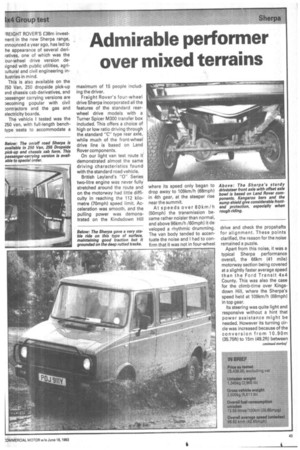Admirable performer over mixed terrains
Page 45

Page 46

If you've noticed an error in this article please click here to report it so we can fix it.
'REIGHT ROVER'S £38m investnent in the new Sherpa range, innounced a year ago, has led to he appearance of several deriratives, one of which was the our-wheel drive version de;igned with public utilities, agri;ultural and civil engineering inJustries in mind.
This is also available on the 250 Van, 250 dropside pick-up and chassis cab derivatives, and Dassenger carrying versions are Decoming popular with civil ..:ontractors and the gas and electricity boards.
The vehicle I tested was the 250 van, with full-length benchtype seats to accommodate a maximum of 15 people including the driver.
Freight Rover's four-wheel drive Sherpa incorporated all the features of the standard rearwheel drive models with a Turner Spicer M300 transfer box included. This offers a choice of high or low ratio driving through the standard "C" type rear axle, while much of the front-wheel drive line is based on Land Rover components.
On our light van test route it demonstrated almost the same driving characteristics found. with the standard road vehicle.
British Leyland's "0" Series. two-litre engine was never fully stretched around the route and on the motorway had little difficulty in reaching the 112 kilometre (70mph) speed limit. Acceleration was smooth, and the pulling power was demonstrated on the Kindsdown Hill where its speed only began to drop away to 109km/h (68mph) in 4th gear, at the steeper rise near the summit.
At speeds over 8 0 km/h (50mph) the transmission became rather noisier than normal, and above 96km/h /60mph) it de veloped a rhythmic drumming. The van body tended to accentuate the noise and I had to confirm that it was not in four-wheel drive and check the propshafts for alignment. These points clarified, the reason for the noise remained a puzzle.
Apart from this noise, it was a typical Sherpa performance overall, the 66km (41 mile) motorway section being covered at a slightly faster average speed than the Ford Transit 4x4 County. This was also the case for the climb-time over Kingsdown Hill, where the Sherpa's speed held at 109km/h (68mph) in top gear.
Its steering was quite light and responsive without a hint that power assistance might be needed. However its turning circle was increased because of the conversion from 1 0.9 Om (35.75ft) to 15m (49.2ft) between On the alpine test track at Chobham the Sherpa showed itself to be a good performer. Its 2.9m (114in) wheel base was 203m (81n) longer than either the Bedford CF or the Transit County 4x4 and despite its narrow track was about to negotiate the difficult course much quicker than the other two.
It is worth mentioning that the Bedford and the Ford were fitted with 406mm (16in) wheels while the Sherpa's were smaller — 356mm (14in). This effectively lowered the van's centre of gravity, contributing towards its excellent road holding in these conditions.
The off-road tests were valuable in that they highlighted the capabilities of the dual-purpose cross-country tyres. After being forced around the rough tracks in the wooded area they performed equally well along mud and waterlogged tracks.
None of the driving comforts which are standard on the Sherpa range are lost from the four-wheel drive version. The vinyl covered seats are very comfortable, giving adequate support to the small of the back which is very necessary to minimise the jarring effect of traversing rough ground.
Instruments and controls are conveniently positioned while the floor-mounted four-wheel drive high or low range control lever is located very close to the left side of the driver's seat.
The engine compartment layout is exactly the same as the normal Sherpa, even down to the increased body panel insulation. Daily maintenance becomes a penance for short persons like myself when reaching over the kangaroo bars to check the engine oil level. Draining the engine oil takes a few minutes longer to get at the sump drain plug because of the protection plate, but this useful little extra is well worth it.
It overcame the possible handicap of having smaller wheels than the others by showing its lively capability. In extreme conditions, the 4x4 Sherpa is a very useful performer over mixed terrain and gives a good return on fuel.








































































































